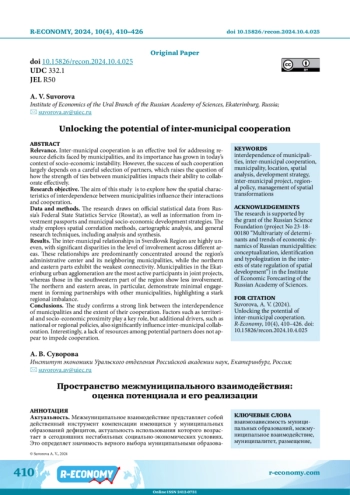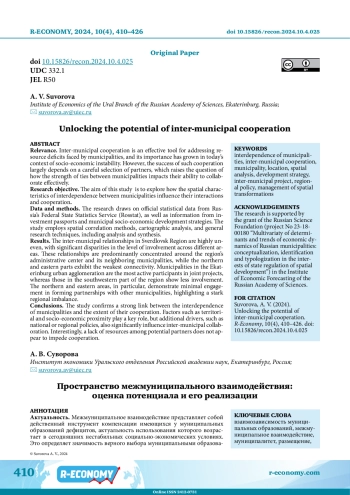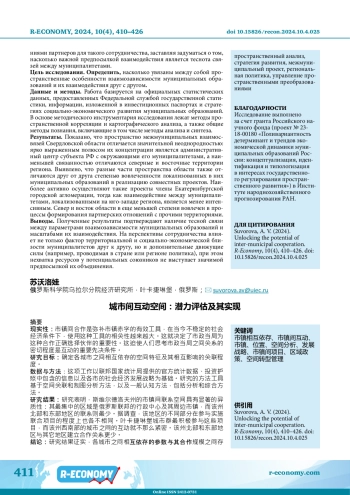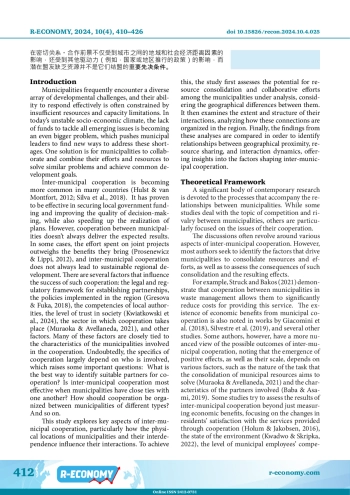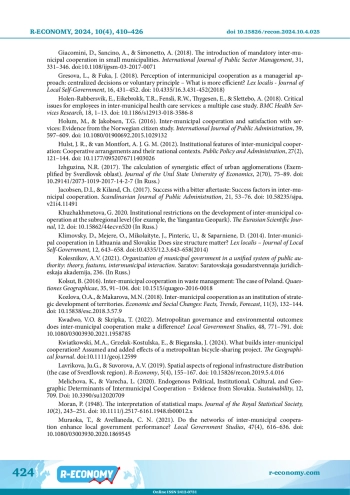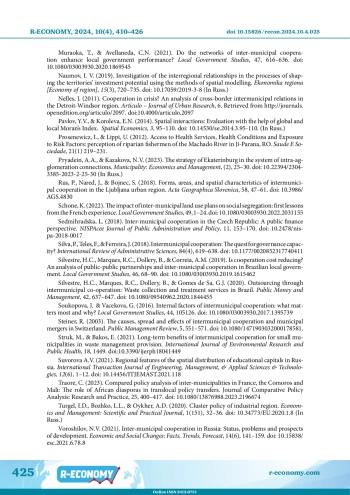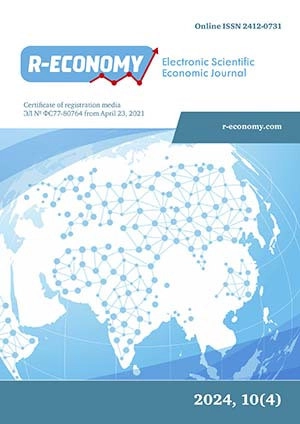Relevance. Inter-municipal cooperation is an effective tool for addressing resource deficits faced by municipalities, and its importance has grown in today’s context of socio-economic instability. However, the success of such cooperation largely depends on a careful selection of partners, which raises the question of how the strength of ties between municipalities impacts their ability to collaborate effectively. Research objective. The aim of this study is to explore how the spatial characteristics of interdependence between municipalities influence their interactions and cooperation. Data and methods. The research draws on official statistical data from Russia’s Federal State Statistics Service (Rosstat), as well as information from investment passports and municipal socio-economic development strategies. The study employs spatial correlation methods, cartographic analysis, and general research techniques, including analysis and synthesis. Results. The inter-municipal relationships in Sverdlovsk Region are highly uneven, with significant disparities in the level of involvement across different areas. These relationships are predominantly concentrated around the region’s administrative center and its neighboring municipalities, while the northern and eastern parts exhibit the weakest connectivity. Municipalities in the Ekaterinburg urban agglomeration are the most active participants in joint projects, whereas those in the southwestern part of the region show less involvement. The northern and eastern areas, in particular, demonstrate minimal engagement in forming partnerships with other municipalities, highlighting a stark regional imbalance. Conclusions. The study confirms a strong link between the interdependence of municipalities and the extent of their cooperation. Factors such as territorial and socio-economic proximity play a key role, but additional drivers, such as national or regional policies, also significantly influence inter-municipal collaboration. Interestingly, a lack of resources among potential partners does not appear to impede cooperation.
Идентификаторы и классификаторы
Municipalities frequently encounter a diverse array of developmental challenges, and their ability to respond effectively is often constrained by insufficient resources and capacity limitations. In today’s unstable socio-economic climate, the lack of funds to tackle all emerging issues is becoming an even bigger problem, which pushes municipal leaders to find new ways to address these shortages. One solution is for municipalities to collaborate and combine their efforts and resources to solve similar problems and achieve common development goals.
Inter-municipal cooperation is becoming more common in many countries (Hulst & van Montfort, 2012; Silva et al., 2018). It has proven to be effective in securing local government funding and improving the quality of decision-making, while also speeding up the realization of plans. However, cooperation between municipalities doesn’t always deliver the expected results. In some cases, the effort spent on joint projects outweighs the benefits they bring (Prosenewicz & Lippi, 2012), and inter-municipal cooperation does not always lead to sustainable regional development.
Список литературы
1. Animitsa E. G., Vlasova N. Yu. (2020). Problems and prospects of urban agglomeration development. Regionalistica, 7(3), 60-66. (In Russ.). DOI: 10.14530/reg.2020.3.60 EDN: INVUGV
2. Antipin I. A., Vlasova N. Yu., Ivanova O. Yu. (2023). Strategic planning in Russian regions: Spatial development issues. Upravlenets/The Manager, 14(6), 50-62. (In Russ.). DOI: 10.29141/2218-5003-2023-14-6-4 EDN: CDKHUU
3. Arumova E. (2013). Organizational schemes and mechanisms of inter-municipal cooperation. City Management, 5, 59-72. Retrieved from http://emsu.ru/extra/pdf5s/um/2013/5/59.pdf. (In Russ.).
4. Baba H., Asami Y. (2019). Municipal population size and the benefits of inter-municipal cooperation: panel data evidence from Japan. Local Government Studies, 46, 371-393. DOI: 10.1080/03003930.2019.1624257
5. Barabash E. S., Leonov S. N. (2012). Intermunicipal cooperation: the potential and implementation mechanism. Khabarovsk: Khabarovsk State Academy of Economics and Law Publishing House, 188. (In Russ.).
6. Bel G., Warner M. E. (2015). Factors explaining inter-municipal cooperation in service delivery: a meta-regression analysis. Journal of Economic Policy Reform, 19, 91-115. DOI: 10.1080/17487870.2015.1100084
7. Bel G., Bischoff I., Blaka S., Casula M., Lysek J., Swianiewicz P., Tavares A. F., Voorn B. (2022). Styles of inter-municipal cooperation and the multiple principal problem: a comparative analysis of European Economic Area countries. Local Government Studies, 49, 422-445. DOI: 10.1080/03003930.2022.2041416 EDN: RMGOFB
8. Bergholz Ch., Bischoff I. (2018). Local council members’ view on intermunicipal cooperation: does office-related self-interest matter? Regional Studies, 52, 1624-1635. DOI: 10.1080/00343404.2018.1428293
9. Bischoff I., Wolfschutz E. (2020). Inter-municipal cooperation in administrative tasks - the role of population dynamics and elections. Local Government Studies, 47, 568-592. DOI: 10.1080/03003930.2020.1771307 EDN: XVUSZO
10. Bocchino M., Padovani E. (2021). Does municipal fiscal distress hinder inter-municipal cooperation? Journal of Public Budgeting, Accounting & Financial Management, 33, 552-574. DOI: 10.1108/JPBAFM-07-2020-0095 EDN: CBKQSG
11. de Freitas B. R., de Oliveira A. R. Dias Cabral K. F. (2020). Structure of public health consortiums: a study in the intermunicipal consortiums of health in the Mata Mineira Area. Research, Society and Development, 9, e171985538-e171985538. DOI: 10.33448/rsd-v9i8.5538 EDN: XDJBVG
12. de Morais L. A., de Freitas L. S. (2023). Intermunicipal consortium for sustainable development and innovation of the state of Paraíba from the perspective of environmental democracy: an analysis of the organizational discourse. Revista de Direito da Cidade, 15, 209-236. DOI: 10.12957/rdc.2023.66194 EDN: CKPHCY
13. dos Santos J. G., da Silva A. L. N., de Melo C. M. O., de Melo Y. M. (2022). Intermunicipal cooperation in the National Environmental Policy: do state capacities matter? Revista de Administração Pública, 56, 745-771. DOI: 10.1590/0034-761220220110x EDN: VDWCKR
14. Dvoryadkina E. B., Dzhalilov E. V., Istomina N. A. (2022). Industrial municipalities in economic space of traditional industrial regions: A programme for research. Journal of New Economy, 2(2), 29-44. (In Russ.). DOI: 10.29141/2658-5081-2022-23-2-2 EDN: UQDFXM
15. Eythorsson G. T. (2019). Decision-making efficiency, accountability and democracy in inter-municipal cooperation arrangements: The case of Iceland. Icelandic Review of Politics & Administration, 15, 21-38. DOI: 10.13177/irpa.a.2019.15.1.2
16. Gendzwill A., Krukowska J., Lackowska M. (2019). Disappointment or unexpected gain? A survey-based study of the motives and outcomes of inter-municipal cooperation in Poland. Miscellanea Geographica, 23, 235-241. DOI: 10.2478/mgrsd-2019-0020
17. Gerstlberger W., Wahl M., Baumann B. (2023). Change management in the context of decision-making behaviour of local politicians regarding inter-municipal cooperation. Scientific Papers of the University of Pardubice, Series D: Faculty of Economics and Administration, 31. doi:0.46585/sp31021854.
18. Giacomini D., Sancino A., Simonetto A. (2018). The introduction of mandatory inter-municipal cooperation in small municipalities. International Journal of Public Sector Management, 31, 331-346. DOI: 10.1108/ijpsm-03-2017-0071
19. Gresova L., Fuka J. (2018). Perception of intermunicipal cooperation as a managerial approach: centralized decisions or voluntary principle - What is more efficient? Lex localis - Journal of Local Self-Government, 16, 431-452. DOI: 10.4335/16.3.431-452(2018)
20. Holen-Rabbersvik E., Eikebrokk T. R., Fensli R. W., Thygesen E., Slettebo A. (2018). Critical issues for employees in inter-municipal health care services: a multiple case study. BMC Health Services Research, 18, 1-13. DOI: 10.1186/s12913-018-3586-8
21. Holum M., Jakobsen T. G. (2016). Inter-municipal cooperation and satisfaction with services: Evidence from the Norwegian citizen study. International Journal of Public Administration, 39, 597-609. DOI: 10.1080/01900692.2015.1029132
22. Hulst J. R., van Montfort A. J. G. M. (2012). Institutional features of inter-municipal cooperation: Cooperative arrangements and their national contexts. Public Policy and Administration, 27(2), 121-144. DOI: 10.1177/0952076711403026
23. Izhguzina N. R. (2017). The calculation of synergistic effect of urban agglomerations (Exemplified by Sverdlovsk oblast). Journal of the Ural State University of Economics, 2(70), 75-89. (In Russ.). DOI: 10.29141/2073-1019-2017-14-2-7 EDN: WGLEXJ
24. Jacobsen D. I., Kiland Ch. (2017). Success with a bitter aftertaste: Success factors in inter-municipal cooperation. Scandinavian Journal of Public Administration, 21, 53-76. DOI: 10.58235/sjpa.v21i4.11491
25. Khuzhakhmetova G. 2020. Institutional restrictions on the development of inter-municipal cooperation at the subregional level (for example, the Yangantau Geopark). The Eurasian Scientific Journal, 12. (In Russ.). DOI: 10.15862/44ecvn520
26. Klimovsky D., Mejere O., Mikolaityte J., Pinteric U., Saparniene D. (2014). Inter-municipal cooperation in Lithuania and Slovakia: Does size structure matter? Lex localis - Journal of Local Self-Government, 12, 643-658. DOI: 10.4335/12.3.643-658(2014)
27. Kolesnikov A. V. (2021). Organization of municipal government in a unified system of public authority: theory, features, intermunicipal interaction. Saratov: Saratovskaja gosudarstvennaja juridicheskaja akademija, 236. (In Russ.).
28. Kolsut B. (2016). Inter-municipal cooperation in waste management: The case of Poland. Quaestiones Geographicae, 35, 91-104. DOI: 10.1515/quageo-2016-0018
29. Kozlova O. A., Makarova M. N. (2018). Inter-municipal cooperation as an institution of strategic development of territories. Economic and Social Changes: Facts, Trends, Forecast, 11(3), 132-144. DOI: 10.15838/esc.2018.3.57.9 EDN: XTJZRR
30. Kwadwo V. O., Skripka T. (2022). Metropolitan governance and environmental outcomes: does inter-municipal cooperation make a difference? Local Government Studies, 48, 771-791. DOI: 10.1080/03003930.2021.1958785 EDN: KGSLNF
31. Kwiatkowski M. A., Grzelak-Kostulska E., Bieganska J. (2024). What builds inter-municipal cooperation? Assumed and added effects of a metropolitan bicycle-sharing project. The Geographical Journal. DOI: 10.1111/geoj.12599
32. Lavrikova Ju. G., Suvorova A. V. (2019). Spatial aspects of regional infrastructure distribution (the case of Sverdlovsk region). R-Economy, 5(4), 155-167. DOI: 10.15826/recon.2019.5.4.016 EDN: SOJWYG
33. Melichova K., Varecha L. (2020). Endogenous Political, Institutional, Cultural, and Geographic Determinants of Intermunicipal Cooperation - Evidence from Slovakia. Sustainability, 12, 709. DOI: 10.3390/su12020709 EDN: AWRCFB
34. Moran P. (1948). The interpretation of statistical maps. Journal of the Royal Statistical Society, 10(2), 243-251. DOI: 10.1111/j.2517-6161.1948.tb00012.x
35. Muraoka T., Avellaneda C. N. (2021). Do the networks of inter-municipal cooperation enhance local government performance? Local Government Studies, 47(4), 616-636. DOI: 10.1080/03003930.2020.1869545 EDN: RMFPWA
36. Muraoka T., Avellaneda C. N. (2021). Do the networks of inter-municipal cooperation enhance local government performance? Local Government Studies, 47, 616-636. DOI: 10.1080/03003930.2020.1869545 EDN: RMFPWA
37. Naumov I. V. (2019). Investigation of the interregional relationships in the processes of shaping the territories’ investment potential using the methods of spatial modelling. Ekonomika regiona [Economy of region], 15(3), 720-735. (In Russ.). DOI: 10.17059/2019-3-8 EDN: JIOXMW
38. Nelles J. (2011). Cooperation in crisis? An analysis of cross-border intermunicipal relations in the Detroit-Windsor region. Articulo - Journal of Urban Research, 6. Retrieved from http://journals.openedition.org/articulo/2097. DOI: 10.4000/articulo.2097
39. Pavlov Y. V., Koroleva E. N. (2014). Spatial interactions: Evaluation with the help of global and local Moran’s Index. Spatial Economics, 3, 95-110. (In Russ.). DOI: 10.14530/se.2014.3.95-110 EDN: SNZGYN
40. Prosenewicz I., Lippi U. (2012). Access to Health Services, Health Conditions and Exposure to Risk Factors: perception of riparian fishermen of the Machado River in Ji-Parana, RO. Saude E Sociedade, 21(1) 219-231.
41. Pryadein A. A., Kazakova N. V. (2023). The strategy of Ekaterinburg in the system of intra-agglomeration connections. Municipality: Economics and Management, (2), 25-30. (In Russ.). DOI: 10.22394/2304-3385-2023-2-25-30 EDN: CIIAXC
42. Rus P., Nared J., Bojnec S. (2018). Forms, areas, and spatial characteristics of intermunicipal cooperation in the Ljubljana urban region. Acta Geographica Slovenica, 58, 47-61. DOI: 10.3986/AGS.4830
43. Schone K. (2022). The impact of inter-municipal land use plans on social segregation: first lessons from the French experience. Local Government Studies, 49, 1-24. DOI: 10.1080/03003930.2022.2031155 EDN: MGBOUM
44. Sedmihradska L. (2018). Inter-municipal cooperation in the Czech Republic: A public finance perspective. NISPAcee Journal of Public Administration and Policy, 11, 153-170. DOI: 10.2478/nispa-2018-0017
45. Silva P., Teles F., Ferreira J. (2018). Intermunicipal cooperation: The quest for governance capacity? International Review of Administrative Sciences, 84(4), 619-638. DOI: 10.1177/0020852317740411
46. Silvestre H. C., Marques R. C., Dollery B., Correia A. M. (2019). Is cooperation cost reducing? An analysis of public-public partnerships and inter-municipal cooperation in Brazilian local government. Local Government Studies, 46, 68-90. DOI: 10.1080/03003930.2019.1615462
47. Silvestre H. C., Marques R. C., Dollery B., Gomes de Sa G. J. (2020). Outsourcing through intermunicipal co-operation: Waste collection and treatment services in Brazil. Public Money and Management, 42, 637-647. DOI: 10.1080/09540962.2020.1844455 EDN: JTQFTE
48. Soukopova J. Vacekova G. (2016). Internal factors of intermunicipal cooperation: what matters most and why? Local Government Studies, 44, 105126. DOI: 10.1080/03003930.2017.1395739
49. Steiner R. (2003). The causes, spread and effects of intermunicipal cooperation and municipal mergers in Switzerland. Public Management Review, 5, 551-571. DOI: 10.1080/1471903032000178581
50. Struk M., Bakos E. (2021). Long-term benefits of intermunicipal cooperation for small municipalities in waste management provision. International Journal of Environmental Research and Public Health, 18, 1449. DOI: 10.3390/ijerph18041449 EDN: IVNGDY
51. Suvorova A. V. (2021). Regional features of the spatial distribution of educational capitals in Russia. International Transaction Journal of Engineering, Management, & Applied Sciences & Technologies, 12(6), 1-12. DOI: 10.14456/ITJEMAST.2021.118 EDN: FBHSGP
52. Traore C. (2023). Compared policy analysis of inter-municipalities in France, the Comoros and Mali: The role of African diasporas in translocal policy transfers. Journal of Comparative Policy Analysis: Research and Practice, 25, 400-417. DOI: 10.1080/13876988.2023.2196674 EDN: XRJHUY
53. Turgel I. D., Bozhko L. L., Oykher A. D. (2020). Cluster policy of industrial region. Economics and Management: Scientific and Practical Journal, 1(151), 32-36. (In Russ.). DOI: 10.34773/EU.2020.1.8 EDN: IUAIFV
54. Voroshilov N. V. (2021). Inter-municipal cooperation in Russia: Status, problems and prospects of development. Economic and Social Changes: Facts, Trends, Forecast, 14(6), 141-159. DOI: 10.15838/esc.2021.6.78.8 EDN: VSLJNM
55. Warner M. E., Aldag A. M., Kim Y. (2020). Privatization and intermunicipal cooperation in US local government services: balancing fiscal stress, need and political interests. Public Management Review, 23, 1359-1376. DOI: 10.1080/14719037.2020.1751255 EDN: DJIYWN
Выпуск
Другие статьи выпуска
Relevance The growing importance of creative industries in Russia’s economy underscores the need for effective management strategies to support the reindustrialization of second-tier cities, with a focus on socio-economic growth and the preservation of local identity. Research Objective The article aims to identify key factors that influence the development and implementation of creative reindustrialization strategies in second-tier cities. Data and Methods Using econometric modeling, the study analyzed data from 50 industrial cities in Sverdlovsk and Chelyabinsk regions (2010-2024), sourced from the Federal State Statistics Service, the Ministry of Construction, Housing and Utilities, and the Presidential Grant Foundation. Results. The study identified key factors contributing to the growth of creative industries, including the expansion of creative sector companies, proximity to regional centers, increased grant applications, the presence of manufacturing enterprises, growth in local government revenue, and the development of new housing. A comprehensive set of government support measures was proposed, encompassing infrastructure development, financial assistance, educational initiatives, informational resources, and regulatory improvements. Conclusions Essential government support to creative industries should include infrastructure development, simplified administrative procedures, tax incentives, institutional and legislative backing, and export promotion. Other support measures can be tailored to the chosen management strategy and regional needs, resulting in the creation of a flexible system centered around local identity.
Relevance. Corruption remains a persistent issue in many countries, including Kazakhstan. By exploring the relationship between the socio-economic characteristics of specific regions and corruption, this research can provide a foundation for informed policy-making and targeted anti-corruption efforts and thus help mitigate its negative impact on regional development. Research Objective. The research aims to assess the impact of corruption on regional socio-economic development in Kazakhstan through the creation and application of a multifactor corruption index. Data and Methods. The study uses official statistical data on corruption offenses and regional socio-economic indicators, including industrial production, fixed asset investments, household expenditures, unemployment rates, and foreign trade volumes. A multifactor index methodology was employed, using Pearson correlation coefficients to calculate averaged absolute values of sub-indices for each indicator. Results. The study found strong correlations between corruption and socio-economic indicators in regions like East Kazakhstan, Abay, Akmola, and Kostanay. The economic structure of these regions plays a key role: East Kazakhstan and Akmola, with dominant mining industries, are more vulnerable to corruption due to public contracts and licensing. Kostanay’s agricultural sector, central to its economy, is prone to corruption in land allocation, subsidies, and procurement. The economic importance of these sectors amplifies the impact of corruption on development, strengthening the correlation. Conversely, regions with lower index values show weaker correlations in the analysis, likely due to economic diversity, incomplete data, or less effective governance mechanisms. Conclusions. The regional specificity of the interrelation between corruption and socio-economic development in Kazakhstan necessitates tailored approaches that consider the unique conditions of each region. These findings can be of interest to policymakers and other stakeholders. The proposed methodology allows for a more precise assessment of both hidden and visible corruption risks, highlighting critical areas for implementing effective anti-corruption measures.
Relevance. Technological sovereignty in the national economy cannot be achieved without a clear understanding of the state of regional industries, particularly their level of technological maturity. This crucial factor drives investment decisions and shapes regional development strategies. However, existing methods for assessing technological development often fail to account for industries’ reliance on foreign technologies and services. Research Objective. The study explores the concept of technological maturity in the context of managing regional industrial development, focusing on the case of regional industries in Russia. Data and Methods. To evaluate the technological maturity of regional industries, we propose an index derived from normalizing key indicators that capture the critical aspects of technological maturity. The normalized indicators are aggregated using the arithmetic mean. Correlation analysis was employed to identify factors influencing technological development. The study is based on official statistics from the Federal State Statistics Service (Rosstat) for 2022. Results. Technological maturity indices are calculated for Russian regions, identifying both strengths and weaknesses. Only nine regions have achieved a medium level of technological maturity, while most remain at low levels. Additionally, many regions leading in terms of technology are highly reliant on imported technologies and services, with minimal exports of domestically developed technologies. These results highlight the need for policy measures tailored to regions’ varying needs and levels of technological maturity. Conclusions The concept of technological maturity provides a strategic framework for regional industrial development that can enhance national economic competitiveness through both embracing modern technologies and ensuring technological independence. The technological maturity index provides a valuable tool for tracking key indicators of technological sovereignty in domestic industries and identifying investment priorities to strengthen it.
Relevance. Russia is currently facing sanctions, which have had significant economic and social consequences. These crises have revealed vulnerabilities in the socio-economic system, highlighting the importance of studying them to better address current challenges and mitigate future risks. Objective. The study aims to identify the vulnerabilities in particular aspects of sustainable development across Russia’s regions during the crises of the past 15 years. Data and methods. The study draws on data from the Federal Statistical Service (Rosstat) to calculate a sustainable development index for regions, which tracks the impact of crises on their economic, social, and environmental sustainability. The index is constructed using a classical method, comprising three averaged sub-indices, each representing one of the three components of sustainable development. A higher index value indicates greater sustainability, with the impact of crises varying across regions. Results. During the 2014 crisis, regions specializing in export-oriented industries or those with a significant share of foreign capital in their economies were hit the hardest. Socially, the most vulnerable regions were those along the Chinese border in the Far East, which were impacted by trade restrictions. The 2020 pandemic had economic effects on nearly all regions, with cities of over a million people and their agglomerations suffering the most due to the abrupt suspension of the tertiary sector. The social sphere responds most quickly to crises, while the environmental component is more inert but shows a negative trend despite the crises. Conclusions. For regions with underdeveloped and monocentric economies, support measures should focus on diversifying industries, particularly those aimed at mass consumption. In coal-mining regions, it’s important to develop service sectors related to the industry during stable periods. For the Far Eastern regions, the main support measure is to stimulate industries geared towards meeting Chinese demand.
Relevance. The well-being of citizens is a key focus of national policies worldwide. Kazakhstan, however, is characterized by significant regional disparities in social well-being, which necessitates targeted programs and investments to improve conditions in less developed areas. Research Objective. This study aims to develop a national adaptive social well-being index to evaluate and spatially map the regions of Kazakhstan. Data and Methods. The methodology included identifying indicators through a literature review and regional data, conducting an expert survey to weight them, and creating a social well-being index. A spatial analysis was then used to calculate the index for each region. Results. The social well-being index shows significant disparities across regions. Astana, Almaty, and Atyrau demonstrate strong social welfare, driven by economic growth and advanced social infrastructure. In contrast, Karaganda, Pavlodar, and Shymkent show lower social welfare, highlighting the need for targeted interventions and investments. Conclusion. The findings offer valuable insights for policymakers to design strategies for sustainable socioeconomic growth in Kazakhstan. The proposed index can help national and regional authorities monitor social well-being.
Relevance. The global imperative for adopting a low-carbon economy resonates worldwide, yet comprehensive assessments specific to the Russian economy remain scant. This is especially important considering the significant differences in the level of transition to sustainable development among Russian regions. Research Objective. This study aims to introduce a robust methodology for evaluating and analyzing the international trade of low-carbon goods (LCGs) across various Russian regions and assessing its effects on fuel combustion emissions. Data and Methods. Data on LCGs trade were obtained from the Federal Customs Service of Russia. In conjunction, datasets from Rosstat and the Central Bank of Russia were incorporated for comprehensive econometric modeling. The analytical framework employed Tobit and quantile regressions. Results. The study uncovers significant disparities among Russian regions regarding the intensity of low-carbon goods exports and imports. This variation highlights the diverse competencies in LCGs production, as well as differing ecological agendas and consumption patterns across regions. Additionally, the research demonstrates that, although the widespread adoption of advanced production technologies is positively correlated with increased fuel combustion emissions, a U-shaped relationship exists where higher LCGs exports are associated with reductions in fuel combustion emissions across Russian regions to a certain degree. Conclusions. This research highlights important implications for both federal and regional industrial and environmental policies. It advocates for the development of targeted incentives that encourage the adoption of low-carbon goods (LCGs) and advanced technologies. By doing so, policymakers can effectively promote sustainable development tailored to the unique needs and conditions of various regions, thereby fostering ecological resilience and economic growth across diverse regional landscapes.
Статистика статьи
Статистика просмотров за 2025 год.
Издательство
- Издательство
- УрФУ
- Регион
- Россия, Екатеринбург
- Почтовый адрес
- 620002, Свердловская область, г. Екатеринбург, ул. Мира, д. 19
- Юр. адрес
- 620002, Свердловская область, г. Екатеринбург, ул. Мира, д. 19
- ФИО
- Кокшаров Виктор Анатольевич (Ректор)
- E-mail адрес
- rector@urfu.ru
- Контактный телефон
- +7 (343) 3754507
- Сайт
- https://urfu.ru/ru
